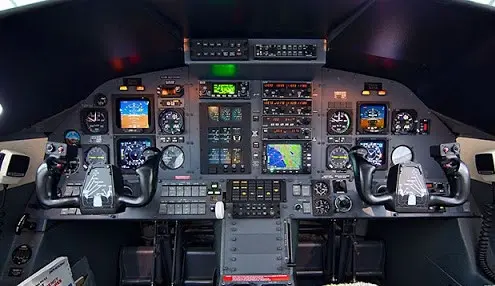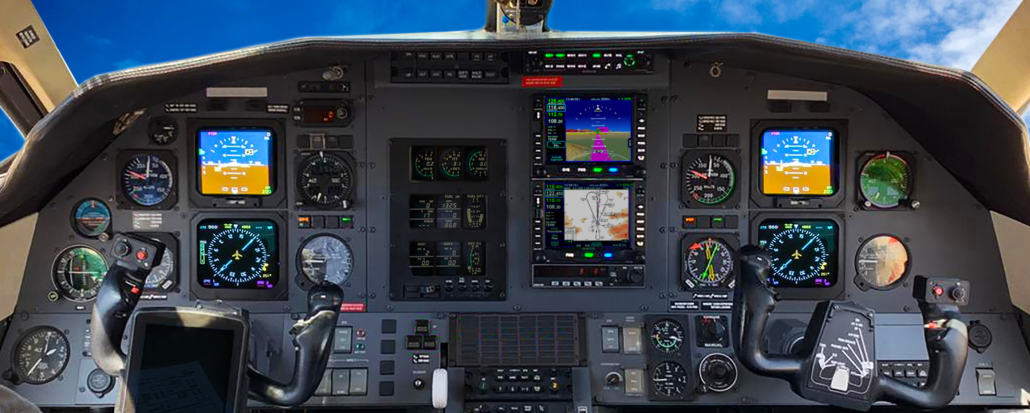A PILATUS PC-12/45 RETROFIT AVIONIC UPGRADE YOU MUST CONSIDER

PILATUS PC-12: A RETROFIT UPGRADE YOU MUST CONSIDER
By: Jorge Hernandez
Every so often a project comes around that truly takes your breath away. Most recently, it was the modernization of a 2004 Pilatus PC-12/45 cockpit.
You should know the Pilatus PC-12 is one of my favorite airplanes. It offers operators the best of both worlds; best-in-class performance and great style. From the NGX to special mission configurations flying over dangerous regions, I have seen this airplane perform the unimaginable and do it without a care.
With that kind of mission versatility, why shouldn’t the avionics capabilities be on par with the aircraft itself? Why settle for anything less than superior if you are operating a Pilatus PC-12?
When I saw the finished product for the first time, it was love at first sight. The modernization included a complete Avidyne CNS suite that truly delivers, providing a feature rich upgrade that is not just highly capable and stylish, but also makes the most of the aircraft’s performance capability all in a single package.
First, you must lose the (irrelevant) weight.

When you consider how much the avionics industry has changed over the last two decades you will quickly notice that when it comes to modern day avionics, less is more. Avionic integration is the answer. Operators prefer highly sanitized panels with an efficient use of space. Let’s take a look at the Pilatus PC-12/45 project completed by Servicio Aereos Montre S.A. de C.V out of Monterrey, Mexico.
Prior to the upgrade, this aircraft was basically factory standard. It was equipped with a KMA24H audio panel, KMD540 multi-function display, KLN90B global positioning system, KX165A NAV/COM, GNS XLS flight management system and dual panel mounted GTX330D transponders. For VHF NAV, interact here, for FMS planning interact there, “IDENT 1234”, interact elsewhere. That is six pieces of factory-issued equipment a crew must master to maximize efficiency, not to mention a lot of weight.
Less is definitely more (and more capable).
After project completion, the aircraft’s new and much improved flight deck boasts a dual IFDs (IFD550, IFD540) installation as the FMS/GPS/NAV/COM system, an AMX240 audio panel and dual AXP322 ADS-B Out remote-mount transponders. All situational awareness equipment on the aircraft like the Storm Scope, Radar, and the Traffic Advisory System (TAS) were all integrated into the dual IFD5-Series.
The aircraft flew away not only with big weight savings and a sleeker panel, but with all safety enhancing information accessible on the dual IFDs. When paired with the Forward Looking Terrain Alerting (FLTA), a feature of the IFD which, by the way, is standard, one could argue that the IFD is serving as more than just an FMS/GPS/NAV/COM. The IFD also provides Multi-Function Display (MFD) functionality which is significantly enhanced when integrated wirelessly with the IFD100 App for IPad®.
The crew now has transponder control, radar control and display with map overlay, Storm Scope display, traffic display, FMS planning, WAAS GPS navigation, VHF communication, VHF navigation, Geo-Referenced Jeppesen Chart Display and terrain alerting all in one system, the IFD 5-Series flight management system. This, in my opinion, makes the Avidyne 5-Series IFD the logical fit for the ever so capable and elegant PC-12/45.
 Avidyne Retrofit Upgrade : IFD550, IFD540 and the AMX240 Audio Panel. Dual AXP322 remote transponders not pictured.
Avidyne Retrofit Upgrade : IFD550, IFD540 and the AMX240 Audio Panel. Dual AXP322 remote transponders not pictured.
Additional possibilities with big benefits.
The Avidyne IFD5-Series was designed as a slide-in replacement for GNS530 GPS navigators. With some Pilatus PC-12/45 aircraft having old GNS navigators currently installed, this is a simple but necessary upgrade. The IFD slides into the same tray and interfaces with the same connectors currently used by the GNS530. To take complete advantage of the all the features the IFD has to offer (not currently available on the now obsolete GNS), the installer will need to add some additional wiring and interfaces. In some cases, the only action required is replacing the GPS antenna for a WAAS TSO-C190 compliant antenna to allow the new FMS to take advantage of navigation with Satellite Based Augmentation System (SBAS) GPS accuracy and adding features such as Localizer Performance with Vertical Guidance (LPV) GPS Approaches.
The benefits do not end at ease of install, weight reduction, consolidation, and cost savings. With the addition of the IFD Series, Pilatus operators can get the most of their existing avionics and give their flying experience an additional enhancement with wireless integration of the IFD100 Application and full bi-directional Foreflight connectivity. Just imagine having your primary source of navigation and situational awareness on a 12″ iPad screen with 100% interactivity and, best of all, for no additional cost. It’s true.
I believe the Avidyne avionic suite is going to find its way into more Pilatus PC-12/45 cockpits as it is simply the best fit for this platform. In my opinion, it resonates with the performance and elegance of the PC-12/45 on all fronts.
